经贸英语文章选读Unit 14 Negotiation_95
- 格式:ppt
- 大小:1.08 MB
- 文档页数:28


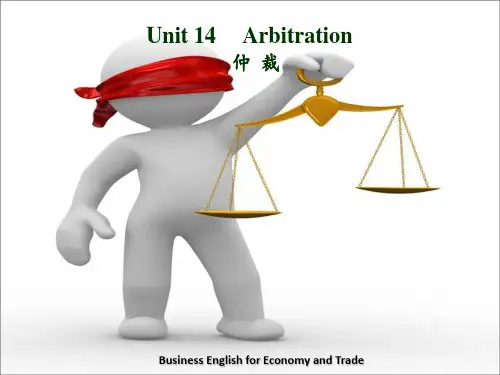
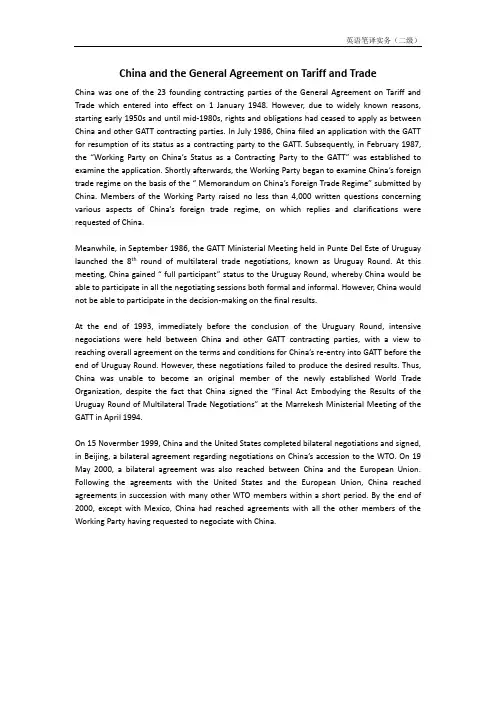
China and the General Agreement on Tariff and TradeChina was one of the 23 founding contracting parties of the General Agreement on Tariff and Trade which entered into effect on 1 January 1948. However, due to widely known reasons, starting early 1950s and until mid-1980s, rights and obligations had ceased to apply as between China and other GATT contracting parties. In July 1986, China filed an application with the GATT for resumption of its status as a contracting party to the GATT. Subsequently, in February 1987, the “Working Party on China’s Status as a Contracting Party to the GATT”was established to examine the application. Shortly afterwards, the Working Party began to examine China’s foreign trade regime on the basis of the “ Memorandum on China’s Foreign Trade Regime” submitted by China. Members of the Working Party raised no less than 4,000 written questions concerning various aspects of China’s foreign trade regime, on which replies and clarifications were requested of China.Meanwhile, in September 1986, the GATT Ministerial Meeting held in Punte Del Este of Uruguay launched the 8th round of multilateral trade negotiations, known as Uruguay Round. At this meeting, China gained “ full participant” status to the Uruguay Round, whereby China would be able to participate in all the negotiating sessions both formal and informal. However, China would not be able to participate in the decision-making on the final results.At the end of 1993, immediately before the conclusion of the Uruguary Round, intensive negociations were held between China and other GATT contracting parties, with a view to reaching overall agreement on the terms and conditions for China’s re-entry into GATT before the end of Uruguay Round. However, these negotiations failed to produce the desired results. Thus, China was unable to become an original member of the newly established World Trade Organization, despite the fact that China signed the “Final Act Embodying the Results of the Uruguay Round of Multilateral Trade Negotiations” at the Marrekesh Ministerial Meeting of the GATT in April 1994.On 15 Novermber 1999, China and the United States completed bilateral negotiations and signed, in Beijing, a bilateral agreement regarding negotiations on China’s accession to the WTO. On 19 May 2000, a bilateral agreement was also reached between China and the European Union. Following the agreements with the United States and the European Union, China reached agreements in succession with many other WTO members within a short period. By the end of 2000, except with Mexico, China had reached agreements with all the other members of the Working Party having requested to negociate with China.中国与《关税和贸易总协定》中国是1948年1月1日生效的《关税和贸易总协定》的23个创始缔约方之一。
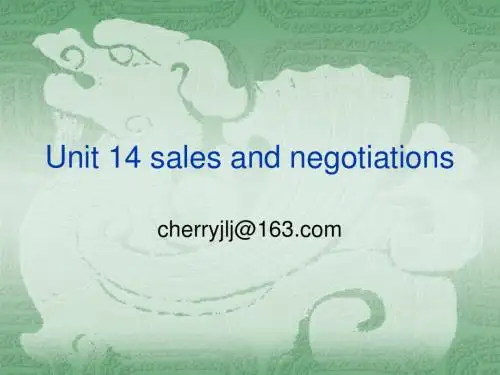
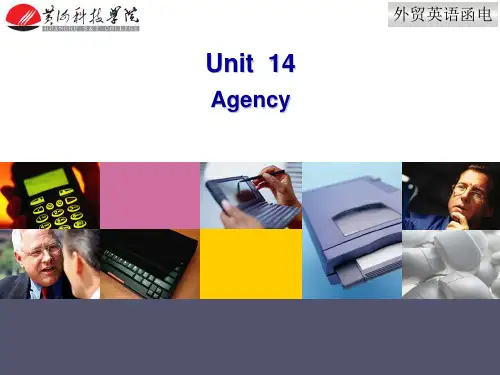

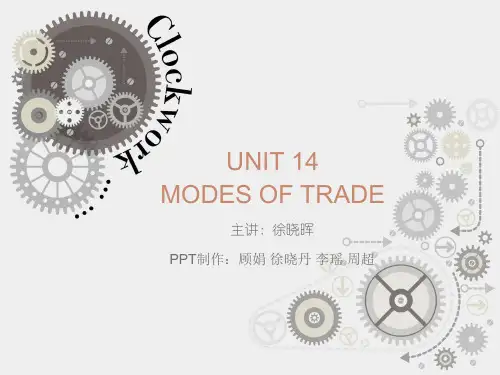
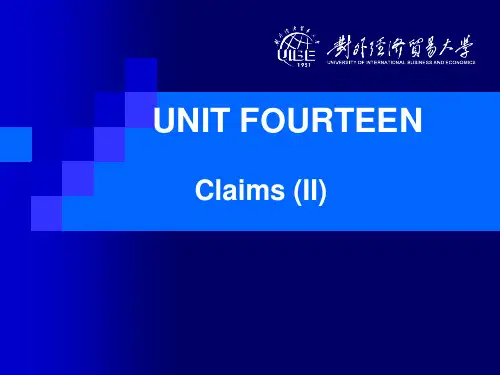
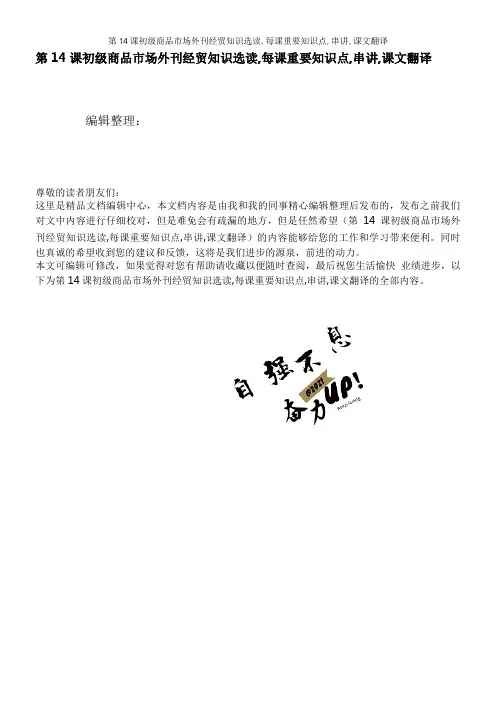
第14课初级商品市场外刊经贸知识选读,每课重要知识点,串讲,课文翻译编辑整理:尊敬的读者朋友们:这里是精品文档编辑中心,本文档内容是由我和我的同事精心编辑整理后发布的,发布之前我们对文中内容进行仔细校对,但是难免会有疏漏的地方,但是任然希望(第14课初级商品市场外刊经贸知识选读,每课重要知识点,串讲,课文翻译)的内容能够给您的工作和学习带来便利。
同时也真诚的希望收到您的建议和反馈,这将是我们进步的源泉,前进的动力。
本文可编辑可修改,如果觉得对您有帮助请收藏以便随时查阅,最后祝您生活愉快业绩进步,以下为第14课初级商品市场外刊经贸知识选读,每课重要知识点,串讲,课文翻译的全部内容。
第14课初级商品市场Soft Commodities非耐用商品一、(Excerpts)(摘录)Many prices are at historic lows, and the IMF expects further falls。
Yet there are signs that the worse may be over。
One key commodity, sugar,has recovered。
许多商品的价格处于历史最低点,虽然国际货币基金组织预计价格还会进一步下跌。
但是,有迹象表明,最糟的局面已经结束了.因为“糖”这种关键性商品的价格已经回升了.Markets Have Lost Their Allure市场已失去吸引力For Most people involved in the production and trading of “soft” or agricultural commodities, this is proving to be a grim decade.对于大多数生产并买卖非耐用商品或农业品的人来说,这十年无疑是阴暗的十年。
Prices are in many cases at,or near, historic lows in real terms as markets struggle to cope with floods of surplus produce.And—with most soothsayers forecasting flat,or still lower,prices-the markets themselves have lost much of their allure.许多情况下,产品的价格都在实际意义上处于或接近历史最低价,这是因为市场要应付泛滥成灾的过剩的农产品。
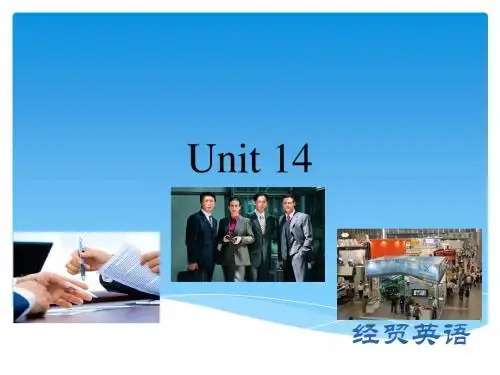
Unit 14a Business Negotiation商业洽谈2.1Listen to an extract from a negotiation.KN=Kate Nelligan from Sophmore Electronics(SE),PB = Pete Boardman from Northern Component(NC)KN: Yes. Shall we turn now to the actual terms?PB: Certainly. Well, we've already discussed price in some detail. I suppose you'd be interested in delivery?KN: Yes, we would. It's critical to meeting our deadlines, as you can imagine.PB: Sure. What sort of delivery periods did you have in mind?KN: Well, you've seen the order quantities, what do you think you could manage?PB: Well, on the AX2000 components, we could certainly...KN: No, I didn't mean on the individual orders. What about the whole consignment, on a monthly basis?PB: Well, I reckon... we could manage 15 days from confirmed order. But as I say, I'd have to get back to you to confirm that.KN: That's at your quoted price?PB: Um... well, actually we quoted for those batch by batch. We hadn't realized you'd be thinking of ordering the whole lot.KN: I see, So I suppose we'd be looking at a reduction for bulk orders.PB: Look, I'm sorry, Miss Nelligan. To be perfectly frank, you've caught me on the hop here.Would you mind waiting while I speak to Geoff on the phone?KN: No,of course not ... Did you get through OK?PB: Yes, I did. I apologize for keeping you waiting. Anyway, we can now talk more concretely about delivery terms.KN: Good.PB: We can deliver the whole consignment in 15 days at the prices already quoted. This would mean dispatch from our premises...KN: I'm surprised you're not prepared to offer some sort of bulk discount considering the size of the order.PB: Well, I'm sure you understand that meeting this sort of order will mean quite a lot of overtime.It would be very difficult to come down on the price.KN: But we are offering you a large amount of regular business.PB: That's true. Would you be willing to sign an annual contract on the basis we discussed?KN: Um, possibly, subject to quality and delivery guarantees.PB: Of course. Well, in that case we could offer a 5% discount for a confirmed monthly order for the next 12 months.KN: I was hoping for something a bit more substantial.PB: I'm afraid that's as far as we could go. We've already stretched ourselves to the limit.KN: Right, Mr Boardman. May I suggest we sign a 6-months' contract at a 5% discount on your quoted prices and then we'll meet again to see if we can reduce the prices further.PB: You're a tough negotiator. OK. Let's shake on that and draw up the details of the first contract...2.2You will hear part of a telephone negotiation about a sale of yogurt between a salesperson anda buyer. Note down your answers to these questions:Listen to a telephone negotiation between a salesperson and a buyer.I=Irena; J=JanI: Let us talk about the yogurt deliveries for Central European market and the North European market.J: Yes, sure.I: Is that OK?J: Yeah, you know for the North European market I can deliver the yogurt fairly quickly.I: The North European area is not going to be a problem. I have approval. But I need to know about the Central European area.J: Yes.I: I am sure we can do a good job.J: Yeah, but you will have to give me some idea about amount or quantities, because that way it is easier to get it through our organization, you know. They need time sometimes, but if they know something about quantity, they'll be more interested.I: Well, I can't say exactly. They depend on price and quality.J: Oh, yes of course.I: If you like, I'll send you a fax and I shall be very open.J: ER...yes.I: I can put in writing to you in quantity terms, that we can take two thousand depending on the price and quality. If your quality is not good and your prices are not competitive, then that'll be the end of our business.J: Sure, of course. I understand. But if the quantity is interesting, I am sure our organization...I: In that case.J: Mrs Eichelberger... I'm sure we can be flexible, because we need, want, figures or quantities.I: I, that is, we are not talking less than one thousand tons...J: Good.I: I am ready to say even a minimum of one thousand tons.J: Yes, good.I: But what if the matter is pushed through quickly? Will everything be OK?J: Yes, of course.I: Perhaps things will move too fast for you and then maybe we'll find that the prices you are quoting us are much too high and the quality is not good and then...J: And then you will have to tell us.I: Yes, then maybe we will stop the order, I tell you, because of that.J: Yes, I see.I: And so can't you let us have one thousand tons now?J: That might not be easy, because ...I: You don't want to do it, that's all.J: It depends, you see.I: OK, then we'll give you time to decide. How long do you need?Unit 14b An International Deal 跨国交易2.ListeningListen to the recording. First decide which order the following points are mentioned in. Then decide which points Marianne (M) raises and which Fritz(F)raises. The first one is done for you as an example in each case.Listen to a conversationF=Fritz; M=MarianneF: Well, I can say, Marianne, I can let you have orders for at least... um...a hundred fifty tons depending on the price and quality, like I said last time. I told you, as we mentioned at the last meeting, if your quality is no good and your prices are not competitive, that's the end of our deal.M: But, of course, Fritz, I understand naturally. Now if we know how much you are putting in an order for, I mean what are you saying , what sort of quantity are we talking about?F: I can safely say my clients ... er... that is one large client needs by next month, at first, eighty toa thousand tons of lavender.M: That's all right. We are flexible and we can do that.F: In that case, Marianne...M: And if the quantity is interesting, I am sure that we can do business. But I must stress, we do require firm figures or quantities, I mean especially if you want a discount, Fritz.F: Well, I am not talking less than one hundred tons.M: That's good. We'll give you a good price on that.F: If we order immediately two hundred in total, then can I expect a discount?M: If the order is made, yes, that's not going to be a problem.F: One more thing, the condition of the product must be perfect, A1 quality. Otherwise we can't do business.M: Of course, naturally, but you know, we only deliver perfect A1 condition. We do have a good reputation, you know.F: But, if we find that the prices you are quoting us are much too high and the quality is not good, Marianne, then we...M: Then, then you must tell us, Fritz.F: But we are trusting your organization.M: I think you will see our lavender is guaranteed A1.F: If there's a guarantee, then we are prepared to take two hundred tons.M: OK. That's good, Fritz, we can give you a 5% discount, then on the total.F: But last time we received 7%. Why so little now, Marianne?M: Ah, well, I'm sorry. But that was on a larger quantity, you see, and this is just two hundred tons. F: Look, I'll sign for two hundred and fifty tons and you give me a 6% discount, what do you say, Marianne?M: OK. Agreed, we'll do that, Fritz.。